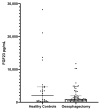Raised FGF23 Correlates to Increased Mortality in Critical Illness, Independent of Vitamin D
- PMID: 36829583
- PMCID: PMC9953634
- DOI: 10.3390/biology12020309
Raised FGF23 Correlates to Increased Mortality in Critical Illness, Independent of Vitamin D
Abstract
Background: Fibroblast Growth Factor (FGF23) is an endocrine hormone classically associated with the homeostasis of vitamin D, phosphate, and calcium. Elevated serum FGF23 is a known independent risk factor for mortality in chronic kidney disease (CKD) patients. We aimed to determine if there was a similar relationship between FGF23 levels and mortality in critically ill patients.
Methods: Plasma FGF23 levels were measured by ELISA in two separate cohorts of patients receiving vitamin D supplementation: critical illness patients (VITdAL-ICU trial, n = 475) and elective oesophagectomy patients (VINDALOO trial, n = 76). Mortality data were recorded at 30 and 180 days or at two years, respectively. FGF23 levels in a healthy control cohort were also measured (n = 27).
Results: Elevated FGF23 (quartile 4 vs. quartiles 1-3) was associated with increased short-term (30 and 180 day) mortality in critical illness patients (p < 0.001) and long-term (two-year) mortality in oesophagectomy patients (p = 0.0149). Patients who died had significantly higher FGF23 levels than those who survived: In the critical illness cohort, those who died had 1194.6 pg/mL (range 0-14,000), while those who survived had 120.4 pg/mL (range = 15-14,000) (p = 0.0462). In the oesophagectomy cohort, those who died had 1304 pg/mL (range = 154-77,800), while those who survived had 644 pg/mL (range = 179-54,894) (p < 0.001). This was found to be independent of vitamin D or CKD status (critical illness p = 0.3507; oesophagectomy p = 0.3800). FGF23 levels in healthy controls were similar to those seen in oesophagectomy patients (p = 0.4802).
Conclusions: Elevated baseline serum FGF23 is correlated with increased mortality in both the post-oesophagectomy cohort and the cohort of patients with critical illness requiring intensive care admission. This was independent of vitamin D status, supplementation, or CKD status, which suggests the presence of vitamin D-independent mechanisms of FGF23 action during the acute and convalescent stages of critical illness, warranting further investigation.
Keywords: FGF23; critical illness; intensive care.
Conflict of interest statement
The authors declare no conflict of interest.
Figures



Similar articles
-
Associations of fibroblast growth factor 23, vitamin D and parathyroid hormone with 5-year outcomes in a prospective primary care cohort of people with chronic kidney disease stage 3.BMJ Open. 2017 Aug 23;7(8):e016528. doi: 10.1136/bmjopen-2017-016528. BMJ Open. 2017. PMID: 28838895 Free PMC article.
-
Fibroblast Growth Factor 23 Associates with Death in Critically Ill Patients.Clin J Am Soc Nephrol. 2018 Apr 6;13(4):531-541. doi: 10.2215/CJN.10810917. Epub 2018 Mar 8. Clin J Am Soc Nephrol. 2018. PMID: 29519954 Free PMC article.
-
Fibroblast Growth Factor 23 Levels Associate with AKI and Death in Critical Illness.J Am Soc Nephrol. 2017 Jun;28(6):1877-1885. doi: 10.1681/ASN.2016080836. Epub 2016 Dec 27. J Am Soc Nephrol. 2017. PMID: 28028134 Free PMC article.
-
Role of FGF23 in vitamin D and phosphate metabolism: implications in chronic kidney disease.Exp Cell Res. 2012 May 15;318(9):1040-8. doi: 10.1016/j.yexcr.2012.02.027. Epub 2012 Mar 7. Exp Cell Res. 2012. PMID: 22421513 Free PMC article. Review.
-
Fibroblast growth factor 23 and disordered vitamin D metabolism in chronic kidney disease: updating the "trade-off" hypothesis.Clin J Am Soc Nephrol. 2010 Sep;5(9):1710-6. doi: 10.2215/CJN.02640310. Epub 2010 May 27. Clin J Am Soc Nephrol. 2010. PMID: 20507957 Review.
Cited by
-
Calcium, Phosphorus and Magnesium Abnormalities Associated with COVID-19 Infection, and Beyond.Biomedicines. 2023 Aug 23;11(9):2362. doi: 10.3390/biomedicines11092362. Biomedicines. 2023. PMID: 37760804 Free PMC article. Review.
-
Vitamin D metabolism in critically ill patients with acute kidney injury: a prospective observational study.Crit Care. 2024 Apr 2;28(1):108. doi: 10.1186/s13054-024-04869-4. Crit Care. 2024. PMID: 38566240 Free PMC article.
-
Blockage of Autophagy for Cancer Therapy: A Comprehensive Review.Int J Mol Sci. 2024 Jul 7;25(13):7459. doi: 10.3390/ijms25137459. Int J Mol Sci. 2024. PMID: 39000565 Free PMC article. Review.
-
Emerging concepts on the FGF23 regulation and activity.Mol Cell Biochem. 2025 Jan;480(1):75-89. doi: 10.1007/s11010-024-04982-6. Epub 2024 Apr 6. Mol Cell Biochem. 2025. PMID: 38581553 Review.
References
-
- Zajic P., Amrein K. Vitamin D deficiency in the ICU: A systematic review. Minerva Endocrinol. 2014;39:275–287. - PubMed
-
- Parekh D., Dancer R.C.A., Lax S., Cooper M.S., Martineau A.R., Fraser W.D., Tucker O., Alderson D., Perkins G.D., Gao-Smith F., et al. Vitamin D to prevent acute lung injury following oesophagectomy (VINDALOO): Study protocol for a randomised placebo controlled trial. Trials. 2013;14:100. doi: 10.1186/1745-6215-14-100. - DOI - PMC - PubMed
-
- Amrein K., Schnedl C., Holl A., Riedl R., Christopher K.B., Pachler C., Urbanic Purkart T., Waltensdorfer A., Munch A., Warnkross H., et al. Effect of high-dose vitamin D3 on hospital length of stay in critically ill patients with vitamin D deficiency: The VITdAL-ICU randomized clinical trial. Jama. 2014;312:1520–1530. doi: 10.1001/jama.2014.13204. - DOI - PubMed
Grants and funding
- NIHR129593/National Institute for Health Research
- 14143/Jubilaumsfonds
- Chernajovsky Foundation
- MCFPHD20F\2/British Lung Foundation
- NIHR17/147/33/National Institute for Health Research
- MR/S002782/1/MRC_/Medical Research Council/United Kingdom
- MR/N021185/1/MRC_/Medical Research Council/United Kingdom
- G1100196/MRC_/Medical Research Council/United Kingdom
- Fresenius Kabi
- Starter Fellowship/Birmingham Health Partners
- MR/X000338/1/MRC_/Medical Research Council/United Kingdom
- NIHR131600/National Institute for Health Research
- MR/J011266/1/MRC_/Medical Research Council/United Kingdom
LinkOut - more resources
Full Text Sources

